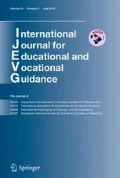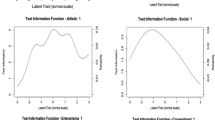Abstract
A new, Holland-based Interest Inventory is proposed, intended to facilitate the transition from secondary to tertiary education. Specific interest items were designed to grasp activities that are prevalent during tertiary studies, including an Academic-track-scale to assist in the choice between academic and vocational-oriented programs. Interest profile descriptions are complemented by a list of matching study programs. Data from 3,962 students were analyzed to evaluate the underlying circumplex structure, the criterion validity of the Academic-track-scale and the study program RIASEC codes. It is concluded that the assessment and feedback tools are promising instruments to facilitate the transition to tertiary education.
Résumé
Explorer les domaines d’études professionnelles et académiques: Développement et validation de l’inventaire d’intérêt flamand SIMON (SIMON-I). Un nouvel inventaire d'intérêt basé sur la théorie de Holland est proposé comme une aide à la transition entre l’enseignement secondaire et tertiaire. Les items étaient construits spécifiquement pour mesurer des intérêts aux activités qui sont prévalent pendant l’enseignement tertiaire, incluant une échelle ‘Académique’ qui aide la choix entre l’enseignement académique soit professionnelle. Les profils d’intérêts sont complété par une liste des programmes correspondent. Les réponses de 3,962 étudiants sont utilisé pour évaluer la structure circumplex, la validité critérielle de l’échelle ‘Académique’ et les codes RIASEC des programmes. Il a été conclu que cet inventaire est valide et utile.
Zusammenfassung
Erforschung beruflicher und akademischer Forschungsfelder: Entwicklung und Validation des flämischen SIMON Interesseninventars (SIMON-I). Ein neues, Holland-basiertes Interesseninventar wird vorgestellt, welches beabsichtigt den Übergang von der sekundären in die tertiäre Ausbildung zu vereinfachen. Spezifische Interessenitems wurden entwickelt um Tätigkeiten zu erfassen, welche in der tertiären Ausbildung überwiegen; inklusive einer „akademischen“Skala um die Wahl zwischen akademischen und beruflich-orientierten Programmen zu unterstützen. Beschreibungen von Interessenprofilen werden durch Listen passender Studiengänge ergänzt. Daten von 3,962 Schülerinnen und Schülern wurden analysiert um die darunterliegende zirkumplexe Struktur, die Kriteriumsvalidität der akademischen Skala und den RIASEC Code der Studienprogramme zu evaluieren. Die Arbeit kommt zum Schluss, dass die Instrumente zum Assessment und zum Feedback ein vielversprechendes Mittel sind, um den Übergang in die tertiäre Ausbildung zu vereinfachen.
Resumen
Explorando campos profesionales y académicos de estudio: Desarrollo y validación del Inventario de Intereses flamenco SIMON (SIMON-I). Se propone un nuevo inventario de interés basado en Holland, destinado a facilitar la transición de la educación secundaria a la superior. Se diseñaron ítems específicos, con el fin de captar las actividades frecuentes durante los estudios superiores, incluyendo una Escala de Trayectoria Académica, para ayudar a la elección entre programas académicos frente a programas orientados a la formación profesional. Las descripciones de perfiles de interés se complementaron con una lista de programas de estudios adecuados. Se analizaron los datos de 3,962 estudiantes para evaluar la estructura subyacente circumplex, el criterio de validez de la Escala de Trayectoria Académica y el programa de estudio de acuerdo con los códigos RIASEC. Como conclusión las herramientas de evaluación y retroalimentación son instrumentos prometedores para facilitar la transición a la educación superior.
Similar content being viewed by others
Notes
The People/Things dimension: (2*R) + (1*I) + (−1*A) + (−2*S) + (−1*E) + (1*C).
The Data/Ideas dimension: (0*R) + (−1.7*I) + (−1.7*A) + (0*S) + (1.7*E) + (1.7*C).
References
Armstrong, P. I., Allison, W., & Rounds, J. (2008). Development and initial validation of brief public domain RIASEC marker scales. Journal of Vocational Behavior, 73(2), 287–299. doi:10.1016/j.jvb.2008.06.003.
Beinicke, A., Pässler, K., & Hell, B. (2014). Does gender-specific differential item functioning affect the structure in vocational interest inventories? International Journal for Educational and Vocational Guidance, 14, 181–198. doi:10.1007/s10775-013-9254-y.
Betz, N. E., & Fitzgerald, L. F. (1987). The career psychology of woman. Orlando, FL: Academic Press.
Borgen, F. H., & Seling, M. J. (1978). Uses of discriminant analysis following MANOVA: Multivariate statistics for multivariate purposes. Journal of Applied Psychology, 63(6), 689–697.
Brown, D. (2002). Career choice and development. San Fransisco: Wiley.
Brown, S. D., & Gore, P. A. (1994). An evaluation of interest congruence indices: Distribution characteristics and measurement properties. Journal of Vocational Behavior, 45(3), 310–327. doi:10.1006/jvbe.1994.1038.
Browne, M. W. (1992). Circumplex models for correlation matrices. Psychometrika, 57(4), 469–497. doi:10.1007/bf02294416.
Campbell, V. L. (1987). Strong-Campbell Interest Inventory. Journal of Counseling & Development, 66(1), 53–56.
Darcy, M. U. A., & Tracey, T. J. G. (2007). Circumplex structure of Holland’s RIASEC interests across gender and time. Journal of Counseling Psychology, 54(1), 17–31. doi:10.1037/0022-0167.54.1.17.
De Fruyt, F., & Mervielde, I. (1996). Personality and interests as predictors of educational streaming and achievement. European Journal of Personality, 10, 405–425. doi:10.1002/(SICI)1099-0984(199612)10:5<405:AID-PER255>3.0.CO;2-M.
De Fruyt, F., & Mervielde, I. (1997). The five-factor model of personality and Holland's RIASEC interest types. Personality and individual differences, 23(1), 87–103. doi:10.1016/S0191-8869(97)00004-4.
de Koning, B., Loyens, S., Rikers, E., Smeets, G., & van der Molen, H. (2012). Generation Psy: Student characteristics and academic achievement in a three-year problem-based learning bachelor program. Learning and Individual Differences, 22(3), 313–323. doi:10.1016/j.lindif.2012.01.003.
Dolnicar, S., & Grun, B. (2007). User-friendliness of answer formats-an empirical comparison. Australasian Journal of Market & Social Research, 15(1), 19.
Dolnicar, S., Grün, B., & Leisch, F. (2011). Quick, simple and reliable: Forced binary survey questions. International Journal of Market Research, 53(2), 231–252. doi:10.2501/IJMR-53-2-231-252.
Eggerth, D. E., & Andrew, M. E. (2006). Modifying the C index for use with Holland codes of unequal length. Journal of Career Assessment, 14(2), 267–275.
Einarsdóttir, S., & Rounds, J. (2009). Gender bias and construct validity in vocational interest measurement: Differential item functioning in the Strong Interest Inventory. Journal of Vocational Behavior, 74(3), 295–307. doi:10.1016/j.jvb.2009.01.003.
Einarsdóttir, S., Rounds, J., Ægisdóttir, S., & Gerstein, L. H. (2002). The structure of vocational interests in iceland: Examining Holland’s and Gati’s RIASEC models. European Journal of Psychological Assessment, 18(1), 85–95. doi:10.1027//1015-5759.18.1.85.
Furnham, A. (2001). Vocational preference and P-O fit: Reflections on Holland’s theory of vocational choice. Applied Psychology, 50(1), 5–29. doi:10.1111/1464-0597.00046.
Germeijs, V., & Verschueren, K. (2007). High school students’ career decision-making process: Consequences for choice implementation in higher education. Journal of Vocational Behavior, 70(2), 223–241. doi:10.1016/j.jvb.2006.10.004.
Grassi, M., Luccio, R., & Di Blas, L. (2010). CircE: An R implementation of Browne’s circular stochastic process model. Behavior Research Methods, 42(1), 55–73. doi:10.3758/brm.42.1.55.
Grotevant, H. D., & Durrett, M. E. (1980). Occupational knowledge and career development in adolescence. Journal of Vocational Behavior, 17(2), 171–182. doi:10.1016/0001-8791(80)90002-0.
Hansen, J.-I. C., Collins, R. C., Swanson, J. L., & Fouad, N. A. (1993). Gender differences in the structure of interests. Journal of Vocational Behavior, 42(2), 200–211. doi:10.1006/jvbe.1993.1014.
Harms, P. D., Roberts, B. W., & Winter, D. (2006). Becoming the Harvard man: Person-environment fit, personality development, and academic success. Personality and Social Psychology Bulletin, 32(7), 851–865. doi:10.1177/0146167206287720.
Harrington, T. F., Feller, R., & O’Shea, A. J. (1993). Four methods to determine RIASEC codes for college majors and a comparison of hit rates. The Career Development Quarterly, 41(4), 383–392. doi:10.1002/j.2161-0045.1993.tb00412.x.
Hogerheijde, R. P., van Amstel, B., De Fruyt, F., & Mervielde, I. (1995). Beroepskeuze Zelf-Onderzoek versie 1995. Een gids voor opleidings-en beroepskeuze. Handleiding-Nederlands/Vlaamse editie. Lisse: Swets, & Zeitlinger.
Holland, J. L. (1985a). Making vocational choices: A theory of vocational personalities and work environments (2nd ed.). Englewood Cliffs, NJ: Prentice Hall.
Holland, J. L. (1985b). The self-directed search: Professional manual. Odessa, FL: Psychological Assessment Resources.
Holland, J. L. (1997). Making vocational choices: A theory of vocational personalities and work environments. Odessa, FL: Psychological Assessment Resources.
Hooper, D., Coughlan, J., & Mullen, M. (2008). Structural equation modelling: guidelines for determining model fit. Electronic Journal of Business Research Methods, 6(1), 53–60.
Hubert, L., & Arabie, P. (1987). Evaluating order hypotheses within proximity matrices. Psychological Bulletin, 102, 172–178.
Malgwi, C. A., Howe, M. A., & Burnaby, P. A. (2005). Influences on students’ choice of college major. Journal of Education for Business, 80(5), 275–282.
Ministerie, van Onderwijs en Vorming. (2012). Hoger Onderwijs in cijfers -Addendum. Retrieved 3 December 2013 from http://www.ond.vlaanderen.be/hogeronderwijs/werken/studentadmin/studentengegevens/HogerOnderwijsInCijfers-addendum20122013.pdf.
Murtaugh, P. A., Burns, L. D., & Schuster, J. (1999). Predicting the retention of university students. Research in Higher Education, 40(3), 355–371.
Nagy, G., Trautwein, U., & Lüdtke, O. (2010). The structure of vocational interests in Germany: Different methodologies, different conclusions. Journal of Vocational Behavior, 76(2), 153–169. doi:10.1016/j.jvb.2007.07.002.
Nauta, M. M. (2010). The development, evolution, and status of Holland’s theory of vocational personalities: Reflections and future directions for counseling psychology. Journal of Counseling Psychology, 57(1), 11–22. doi:10.1037/a0018213.
Nye, C. D., Su, R., Rounds, J., & Drasgow, F. (2012). Vocational interests and performance: A quantitative summary of over 60 years of research. Perspectives on Psychological Science, 7(4), 384–403. doi:10.1177/1745691612449021.
OECD. (2011). Education at glance 2011: OECD indicators. Paris: OECD Publishing.
OECD. (2013). Education at glance 2013: OECD indicators. Paris: OECD Publishing.
OECD. (2014). Education at glance 2014: OECD indicators. Paris: OECD Publishing.
Pässler, K., Beinicke, A., & Hell, B. (2014). Gender-related differential validity and differential prediction in interest inventories. Journal of Career Assessment, 22(1), 138–152. doi:10.1177/1069072713492934.
Prediger, D. J. (1982). Dimensions underlying Holland’s hexagon: Missing link between interests and occupations? Journal of Vocational Behavior, 21(3), 259–287. doi:10.1016/0001-8791(82)90036-7.
Reardon, R., & Bullock, E. (2004). Holland's theory and implications for academic advising and career counseling. Technical Report 38.
Rounds, J., Smith, T., Hubert, L., Lewis, P., & Rivkin, D. (1999). Development of occupational interest profiles for O*NET. Raleigh, NC: National Center for O* NET Development.
Rounds, J., & Tracey, T. J. G. (1993). Prediger’s dimensional representation of Holland’s RIASEC. Journal of Applied Psychology, 78(6), 75–890. doi:10.1037/0021-9010.78.6.875.
Rounds, J., & Tracey, T. J. G. (1996). Cross-cultural structural equivalence of RIASEC models and measures. Journal of Counseling Psychology, 43(3), 310. doi:10.1037/0022-0167.43.3.310.
Shealy, R., & Stout, W. (1993). A model-based standardization approach that separates true bias/DIF from group ability differences and detects test bias/DTF as well as item bias/DIF. Psychometrika, 58(2), 159–194.
Smart, J. C. (1997). Academic subenvironments and differential patterns of self-perceived growth during college: A test of Holland's theory. Journal of College Student Development, 38(1), 68–78.
Spokane, A. R. (1985). A review of research on person-environment congruence in Holland’s theory of careers. Journal of Vocational Behavior, 26(3), 306–343.
Su, R., Rounds, J., & Armstrong, P. I. (2009). Men and things, women and people: A meta-analysis of sex differences in interests. Psychological Bulletin, 135(6), 859–884. doi:10.1037/a0017364.
Sverko, I., Babarovic, T., & Medugorac, V. (2014). Pictorial assessment of interests: Development and evaluation of pictorial and descriptive interest inventory. Journal of Vocational Behavior, 84(3), 356–366. doi:10.1016/j.jvb.2014.02.008.
Tabachnick, B. G., & Fidell, L. S. (2007). Using multivariate statistics. Boston: Pearson Education.
Tinsley, H. E. A. (2000). The congruence myth: An analysis of the efficacy of the person-environment fit model. Journal of Vocational Behavior, 56(2), 147–179. doi:10.1006/jvbe.1999.1727.
Tracey, T. J. G. (1997). RANDALL: A Microsoft FORTRAN program for a randomization test of hypothesized order relations. Educational and Psychological Measurement, 57(1), 164–168. doi:10.1177/0013164497057001012.
Tracey, T. J. G., & Rounds, J. B. (1993). Evaluating Holland’s and Gati’s vocational-interest models: A structural meta-analysis. Psychological Bulletin, 113(2), 229–246. doi:10.1037/0033-2909.113.2.229.
Tracey, T. J. G., & Rounds, J. (1996). The spherical representation of vocational interests. Journal of Vocational Behavior, 48(1), 3–41. doi:10.1006/jvbe.1996.0002.
UNESCO. (1997). Operational manual for ISCED 1997 (International Standard Classification of Education) (1st ed.). Paris: UNESCO.
Wille, B., De Fruyt, F., Dingemanse, S. A., & Vergauwe, J. (2015). A closer look at the psychological diversity within Holland interest types: Construct validation of the Career Insight Questionnaire. Consulting Psychology Journal: Practice and Research, 67(3), 234.
Wille, B., Tracey, T. J. G., Feys, M., & De Fruyt, F. (2014). A longitudinal and multi-method examination of interest–occupation congruence within and across time. Journal of Vocational Behavior, 84(1), 59–73. doi:10.1016/j.jvb.2013.12.001.
Wolniak, G. C., & Pascarella, E. T. (2005). The effects of college major and job field congruence on job satisfaction. Journal of Vocational Behavior, 67(2), 233–251. doi:10.1016/j.jvb.2004.08.010.
Author information
Authors and Affiliations
Corresponding author
Appendix
Rights and permissions
About this article
Cite this article
Fonteyne, L., Wille, B., Duyck, W. et al. Exploring vocational and academic fields of study: development and validation of the Flemish SIMON Interest Inventory (SIMON-I). Int J Educ Vocat Guidance 17, 233–262 (2017). https://doi.org/10.1007/s10775-016-9327-9
Received:
Accepted:
Published:
Issue Date:
DOI: https://doi.org/10.1007/s10775-016-9327-9




